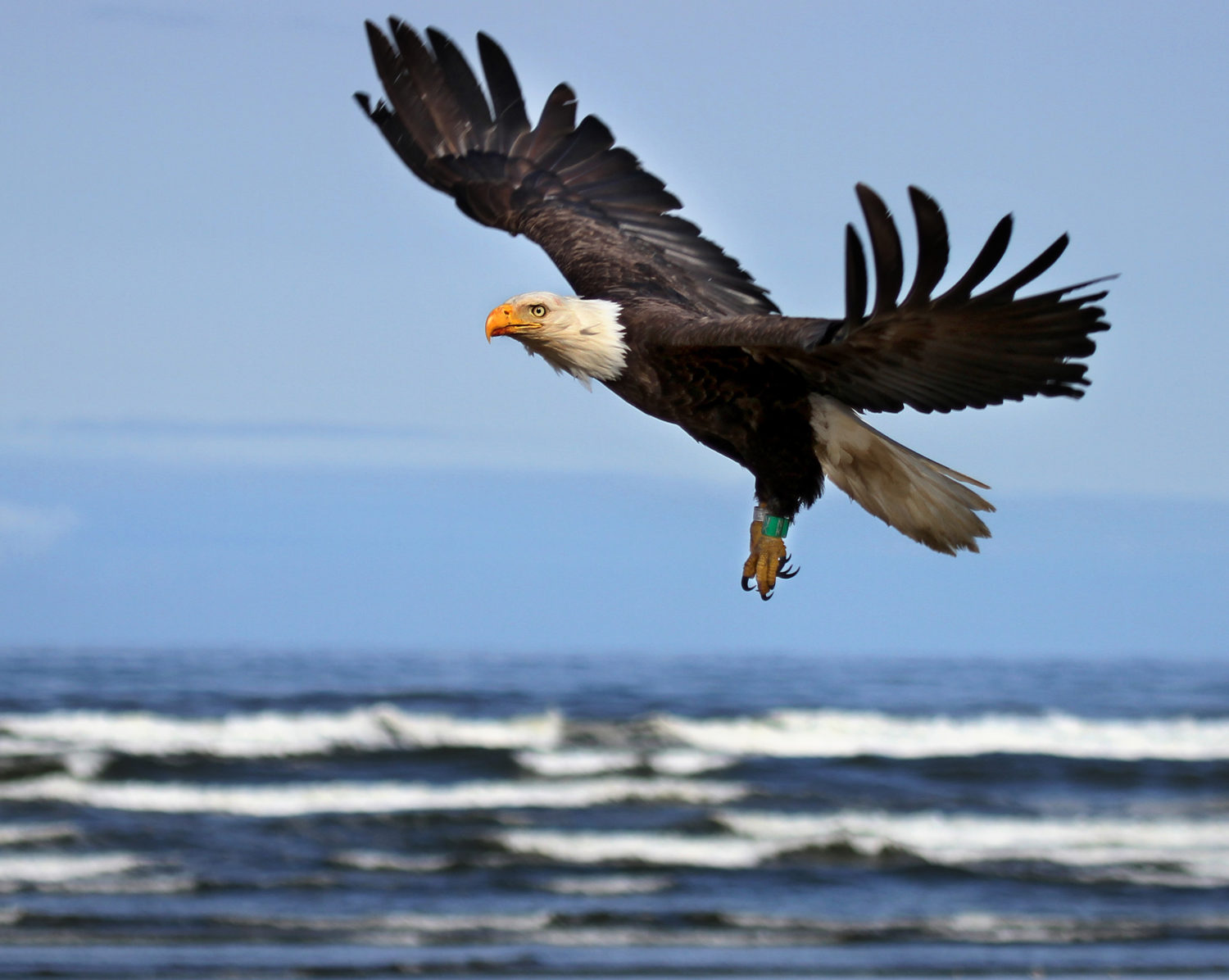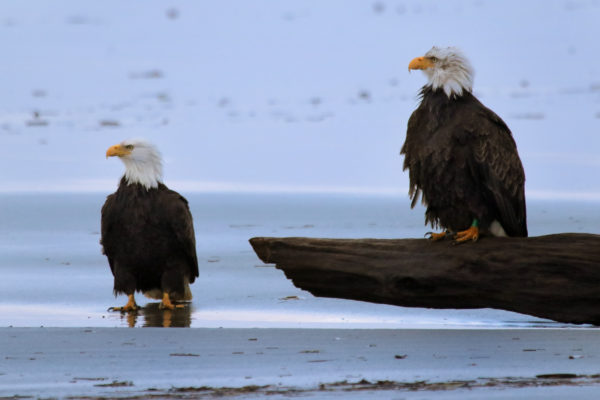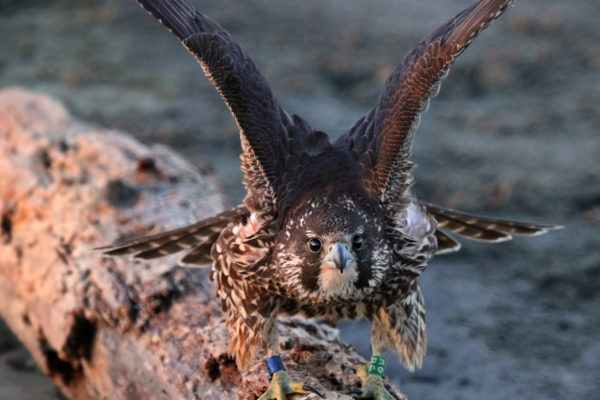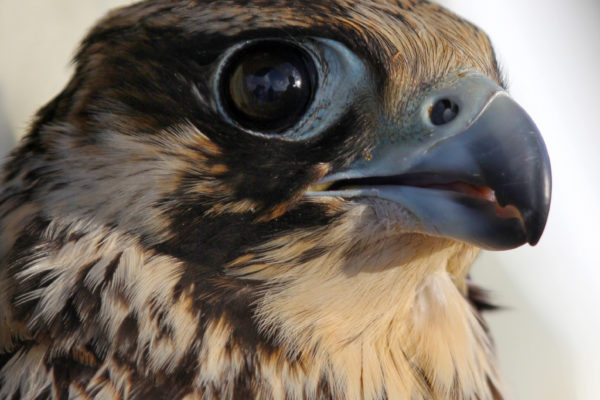

As the two 4-by-4 vehicles slowly crawl up the beach past Ocean City, a distinctive shape appears in the distance on the horizon.
“Flies like an eagle,” says the confident watchful eyes of Tom Rowley, volunteer photographer for the Coastal Raptors. He’s on the lookout during a recent spring survey of raptor activity from Copalis Beach to the North Jetty and back to Ocean Shores over a four-hour period.
Started and directed by Dr. Dan Varland, Coastal Raptors is a non-profit effort that has been tracking and studying the North Beach populations of eagles, peregrine falcons, turkey vultures, ravens and other winged majesties of the coast for the past two decades with the help of volunteers like Rowley.
“I am the only raptor biologist on the coast, so I use volunteers pretty heavily to help me with the work, and it’s worked out really well,” Varland said.
Varland has been monitoring coastal raptors since the 1990s when he came to work for the timber company Rayonier as a wildlife biologist after receiving his Ph.D in animal ecology in 1991 from Iowa State University.
In that time, he has caught and banded more than 250 peregrine falcons and eagles, documenting the age, sex and species, as well as locations from Long Beach to the Copalis River, spanning most of the south Washington coast. At the same time, Rowley has taken countless photographs that tell the full story of the success of their efforts.
“Just the photos tell the story of the magnificence of these birds,” Varland said. “They help foster an appreciation and commitment to conservation among the public, and that’s what we really need … and the science helps us get down to the nitty-gritty to answer the question — ‘Which conservation measures, if any, are really needed?’”
On the spring survey with longtime photographer and friend Rowley — along with a group of two students and a professor from the Washington State University veterinarian program — Varland demonstrated some of his techniques for observing, and sometimes capturing, sampling and banding the raptors for study, while Rowley took photos of the birds and beach environment.
One of the tools to catch the birds is a 20-by-20 foot square net that essentially is shot out over the sought-after raptors. Often, it is covered like a pile of washed-up driftwood and baited — ideally something on the beach the birds would eat. It took Varland nearly a year and a half of trial-and-error research until he finally figured out a way to blast the net using .22-caliber blank shells so that it would cover and catch the birds.
Raptors are smart birds, Varland notes, and catching them takes an equal amount of cunning.
“What we have found for eagles is that you want to have your bait where they are feeding, 12 or 13 feet away from the launcher, because they are so fast,” he said of the process.

Research in action
Captured peregrine falcons are given a green or black-over-blue visual identification band and a red or blue U.S. Geological Survey band.
“We anodize USGS bands to distinguish between peregrine falcons we band at Long Beach from those we band at Ocean Shores and Grayland. Red bands are applied to peregrines we capture at Long Beach and blue bands to those captured at Ocean Shores and Grayland. We are the only researchers banding peregrines with USGS bands anodized red or blue, so the color coding also allows us to distinguish our banded peregrines from peregrines banded by other researchers,” Varland noted on his website.
Peregrine falcon visual identification bands have a letter-letter, letter-number or number-number code.
Peregrine falcons were on the endangered list from 1974-1999, but they now have been taken off with the virtual elimination of the now-banned insecticide DDT from the food chain.
“What we have found through our research is very positive, and it’s a good story,” Varland said. “The eagle numbers are clearly going up. The peregrine falcon numbers are holding steady.”
They also observe northern harriers and merlins, a species of small falcon, which appear to be diminishing in numbers.
On another front, Coastal Raptors is establishing a baseline of information on bald eagles, turkey vultures and ravens — by screening them for the presence of avian diseases and the presence of contaminants such as lead. Part of the effort is to help show if there is the possibility of introducing the rare California condor into the area.
California condors, Varland said, are particularly susceptible to lead poisoning, and determining lead exposure in the local birds is considered an important task in reintroducing the species that once ranged into the Pacific Northwest. Bald eagles, removed from the endangered list in 2007, and ravens also have similar feeding patterns.
Coastal Raptors most recently has been testing to determine if raptors, like waterfowl, can carry the avian influenza disease and survive. By the end of last year, Coastal Raptors had tested 51 birds for exposure to avian influenza: 18 bald eagles, 16 turkey vultures, 13 peregrine falcons and four common ravens.
While a few tested positive for exposure, none were positive for a more deadly strain knows as “highly pathologic avian influenza,” according to the Coastal Raptors December report. Another part of Coastal Raptors research is testing for the presence of mercury in peregrine feathers.

Volunteer network
Varland relies on a network of volunteers to help with the surveys and assist in the captures and banding work. On the early March survey, the beach area is divided into four transects, and one volunteer records all the people, vehicles and dogs, either on a leash or running free, whether on the dunes, beach or access roads. The survey is done while driving, so no raptors are counted while stopped for more than a minute.
There are about 50 such driving surveys he does in a year, and you can follow the results on his Coastal Raptors website.
“We’ve got photo documentation of nearly all of the birds we have captured over the years on the website,” Varland said.
Rowley, one of Varland’s longtime collaborators, is a retired physician who came to live in Hoquiam in 1977 after his radiology residency at the University of Washington. The two recently collaborated on the Polson Museum’s first natural history exhibit, with 31 framed photos and more than 500 images taken from their surveys over the years.
“Tom chanced to meet Dan Varland more than 20 years ago and has regularly accompanied him on his surveys. From the start he has participated helpfully with camera in hand, making a lasting, visual record of Coastal Raptors’ scientific work and the wild, natural, rugged beauty of our coast,” the Polson Museum said in its introduction to the exhibit.
The two met at church in Hoquiam and then went out for coffee, Varland recalled.
“We got to talking about my surveys, and he was interested in going, and he’s been going ever since,” Varland said. “He just has an interest in the outdoors and nature, and he’s been taking photos since the first trip out. He’s just gotten better with his photography with better equipment over the years.”
Although he spends countless hours on the beaches observing the raptors, Varland notes that 95 percent of his time is still spent in his office.
“If you are going to do science, you’re going to be behind a desk,” he said with some chagrin.
Varland’s work has been steadily drawing more attention along with individual contributions to fund Coastal Raptors.
Last April, Varland received a special achievement award for his work from the Washington chapter of the Wildlife Society. Varland also works closely with Dr. Scott Ford, a certified avian veterinarian of national prominence. Together they started the continuing avian scavenger study. Ford is an associate editor of the Journal of Avian Medicine and Surgery, and he recently asked Varland to contribute to a “Notes from the Field” section in the journal.
Varland described how two Quinault tribal members one day encountered him on the beach preparing for a capture.
“When the net launcher goes off, it makes a big boom, and when they heard that, they came over and became part of the process,” he said. “Once we had the bird secure, they got a chance to hold it before we released it, and it was a very special moment for them and for the rest of us.”
The Quinaults later returned the favor, showing Varland an original canoe paddle with a carved eagle on it, a memento they had created to honor the work he has done.